

Highland and Moray - Part 2 of 3 - Tioram Castle Yet another beautiful but hidden away location in Scotland, but this one also has a ruined Castle |
Tioram Castle (with the name 'Tioram', being pronounced locally as 'Cheer-um'), or "Tioram Caisteal" as it is written in Scottish Gaelic and which translates into English as "Dry Castle", is a 12th century ruin, that sits on top of a small tidal island called Eilan Tioram at the head of Loch Moidart on the North West coast o Scotland. And where it is also known by archeologists, that these castle ruins, were actually built over a much more ancient viking wooden fort, based on the many viking artifacts found in this area and which have been dated back to the Bronze age in the 7th century. The castle then became the stronghold of the MacDonalds of Clanranald, who held onto it and its strategic position, for many hundreds of years. Then under the control of Allan MacRuari, who happened to be the current Clan Chief of the time and who is said to have been someone, who enjoyed terrorising all his neighbours and pillaging their villages, to take whatever he wanted. But after his latest hit-and-run raid on a local village and the number of people who had suffered as a consequence, the Clan Chief of the MacLeans of Duart, heard about what Allan MacRuari had done and his atrocious behaviour, and decided he would do something about him and his wayward clan once and for all and wipe them out. So the Chief of the MacLeans of Duart, gathered all the fighting men he could muster from the surrounding area and launched a fleet of ten ships to attack Tioram Castle and kill Allan MacRuari and his Clan. But Allan MacRuari not knowing this attack was coming, had already set out on a single ship, for yet another pillaging attack further up the coast. So when he saw the fleet of ten ships heading towards him and realised that he did not have the time nor the speed to escape. He told one of his crew to pick up his pipes and begin playing a funeral lament, as he lay down on the deck and covered himself in a tartan blanket and pretended to be dead. |
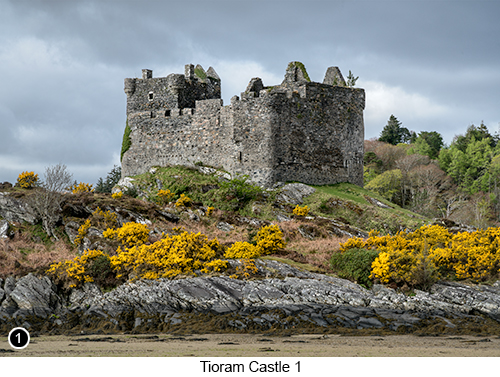 |
| The MacDonald's fleet pulled alongside Allan MacRuari's ship, to be told by the crew how they had killed him themselves, because they had grown tired of all the evil acts he was making them do and how they were all full of remorse, as they now headed towards the Holy Island of Iona, to bury him there and burn out his ship. The Chief of the MacLeans of Duart, believing in the solemn sanctity of a funeral ship and not wanting to impede it on its final journey, swallowed the story and let them pass by and thought to himself, how it would be a fitting final act to this saga, if he continued on with his task to destroy Castle Tioram and any remnants of Allan MacRuari's Clan still in it. | |
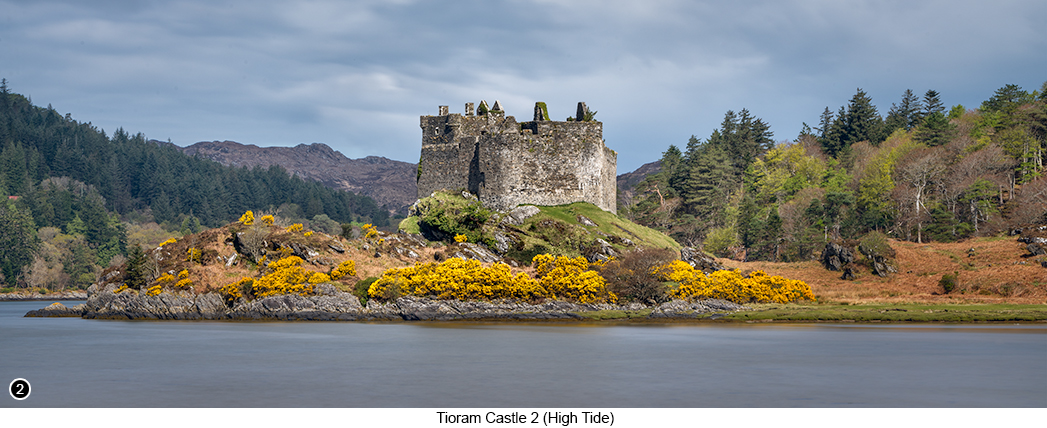 |
|
Then once out of sight of the MacDonald's fleet, Allan MacRuari jumped back up from the deck and ordered his crew to sail as quickly as they could towards the mainland and their original target. He then began to loot and set fire to all the villages along the coastline and cause as much mayhem as he could. But the MacDonald's fleet, having now landed next to Tioram Castle and discussing how they would attack it and destroy it, happened to look back out to the mainland and realise they had been duped and what was now happening to all their families and possessions and how everything they owned, was being destroyed before their very eyes. So they all jumped back aboard their ships, despite the Clan Chief MacDonald pleading with them to complete their task and destroy the castle, but they all ignored him and set off back to their burning villages, to see what and who could be saved. Allan MacRuarie knew this would happen, as soon as the MacDonald men saw what he was doing, as he watched them hastily set sail to return. So he quickly gathered all his men back together and ordered that his ship be pulled out of the sea and onto the shoreline. Where he then had his men pull it through the woods using pulleys and ropes and then into a nearby river, where he could re-launch it, before doubling back around to the mainland to avoid the returning fleet. He then headed back up the coast to his Tioram Castle stronghold, to once again fully escape any consequences for his atrocious acts, as well as to keep both his castle and his tyrannical control over the area, fully in tact. |
|
|
How to get there - From Arisaig and the Rhu Peninsula, get back onto the A830 where you came in and turn immediately right, Street View, Map View, as you now continue along A830 heading towards Fort William. Then after driving for another 7 miles or so, you will reach a new section of road that arcs around to your right, with views out to a line of small islands (Skerry) across the other side of the bay, as shown in SHOT 4 below. This is a view I have already discussed in the Morar chapter elsewhere on this site, so if you are interested in shooting this view (and why wouldn't you?), then please read that chapter first. Although I must say, that the view shown in SHOT 4 below, is a view I seem unable to drive past without wanting to take a shot or two of it. And even though I think the shots I have taken of this view so far are OK, I still think they are not showing it at its full potential, or better still during a sunset. Which means I will just have to keep going back for more, until I do get a shot that fully hits the mark for me. From Arisaig and the Rhu Peninsula to Tioram Castle, is a drive of around 30 miles or so and which should take you around 45 minutes or maybe a little longer. Because some of this part of your journey, is going to be along single track roads with passing places. So depending on when you are here and the amount of traffic (mainly tourists in camper vans in the height of summer, who are not yet used to driving along single track roads, especially in large eight berth vehicles), means it could take you considerably longer than 45 minutes to complete. |
Which means it is better and safer if you just go with the flow, because trying to overtake them (unless they pull in to allow you to pass, which they never do), is pretty much impossible. So instead take your time and enjoy the scenery, as you crawl towards your next photographic destination. However, outside of the summer tourist season, you will find most of this area and its roads will be totally deserted, so you should be able to make good progress at these times. You will then come to a junction with the A861 on your right heading towards Glenuig, Kinlochmoidart and Acharacle, Street View, Map View, so take this right hand turn and continue driving along the A861. You will then continue along the A861 for several more miles, until you come to another right hand turn down Dorlin Road, Street View, Map View and which will take you all the way down to the castle car park. So take this right hand turn. |
|
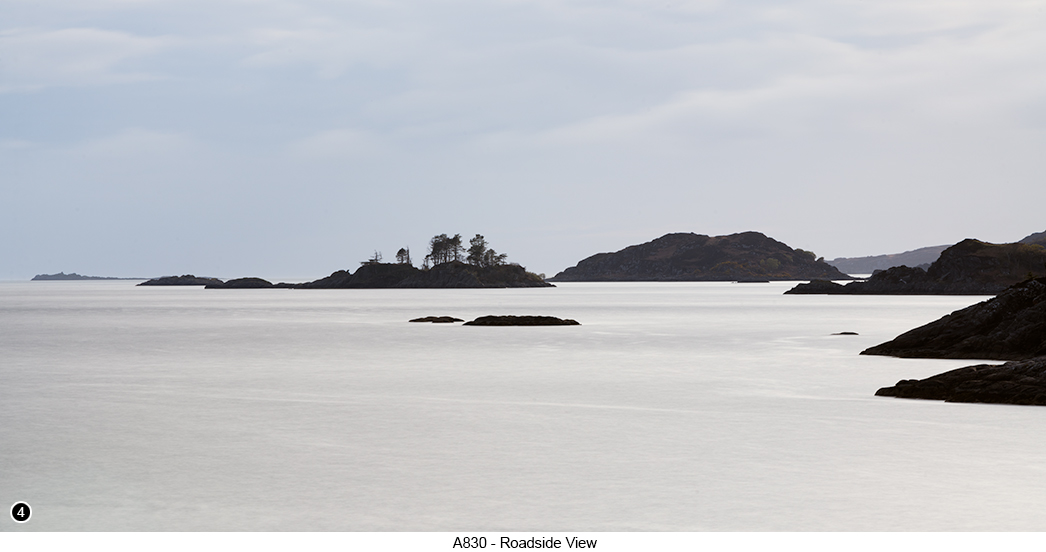 |
|
| But immediately after taking the Dorlin Road turn off, you will soon arrive at a couple of really pretty viewpoints, that I know you will want to photograph, Street View of the Loch, Street View of the Bridge, Map View. One is of an old stone bridge, with a fast flowing burn running beneath it and which I didn't get a decent shot of, because it was far too bright and windy on both of the days we were there. And the second view looking down a pretty little Salmon loch, surrounded by the Lord of the Manor's private fishing piers and which I did manage to get a shot of and is why I am showing it to you here in SHOT 5 below right. | |
Unfortunately there is no room to park anywhere near to the old bridge, other than a small passing place for other vehicles and which you should never use to park your vehicle. As these passing places are only there for one purpose and that is to allow vehicles, to safely pass each other by on a single track road. Which means that anyone who does choose to park here, will be effectively blocking off this narrow road and no one will be able to get through, whenever two cars going in opposite directions meet here and believe me, this seems to happen quite often. So unless you are prepared to get shouted at by irate locals, who just want to get on with their daily business and who as a result will quickly become red faced and annoyed, at tourists blocking their access, then please heed my advice and do not park in this passing place, even for a moment. So what I suggest you do instead, is to drive back out the way you came in and find somewhere else to park near to the woods and then walk back down the short distance to this viewpoint, where you will then be able to work in comfort and ignore the commotion and tooting horns going on behind you, as someone else blocks off the road. You are probably reading this now and thinking to yourself, "Oh come on Dave, people really can't be that inconsiderate can they?" And my answer would Yes, all the time! So having finished shooting the old bridge and the loch as shown on the right. Continue on down Dorlin Road, which soon gets very tight and narrow, as well as not being very well maintained in places, Street View, Map View. Until you reach the large official parking area for Tioram Castle on your right, which is also not very well maintained near to the entrance and park wherever you can. |
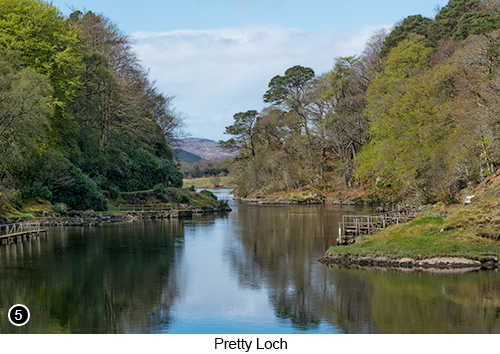 |
From the 'T' junction just before you reach the car park, you will see a private road to your left, that runs through some white gates that are normally left open. If you walk through these gates and follow the road a little way around, as it arcs to the right. Until you are aligned with the old Manor house directly behind you, as shown here in SHOT 6 below left, but looking out towards Tioram Castle as shown in SHOT 2 above. You will then be standing in the exact spot, where I chose to setup for a long exposure shot of the castle at high tide, as well as to spin my camera around on the tripod, to grab a shot of the old Manor House directly behind me, which is again shown in SHOT 6 below left. If you then walk to your right and back towards the car park, you will see at low tide, that there are some old stone steps, that lead down to the beach on your left and where you can then walk out across the beach to shoot the castle as you move towards it, as shown in SHOTS 1 and 3 towards the Top of this page. |
|
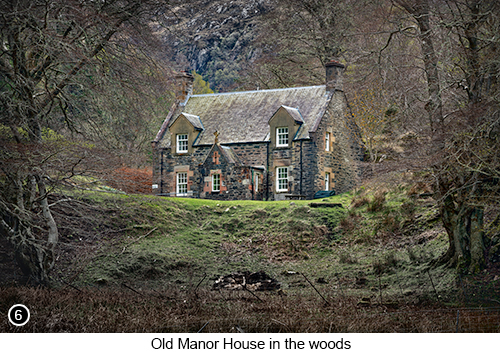 |
I mentioned above, how I was unable to shoot the old bridge, because the light was far too bright and how it was also very windy. Yet if you look at the shot of the salmon loch shown in SHOT 5 directly above, it looks quite reflective and calm, even though I took this shot at the same time as I was trying to shoot the old bridge. Well the reason this is so, is that the light when I was shooting the loch, was coming from over my left shoulder, so a lot of the trees on the right of this shot, were being front lit, but then also reflecting some of their light onto the darker trees to the left of the shot. Whereas with the old bridge, the sun was high up in the sky and slightly behind it. So that everything I looked at in that direction, was being brightly lit with very high contrasty light. As well as being covered in specular highlights on the leaves of the trees and bushes and especially on the water as it flowed out from under the bridge. I did take several shots of it of course, because why not? And if for no other reason than it looks just so darn pretty. But the dynamic range between the highlights and the shadows, was simply far too great for me to get anything useable. The wind was also blowing the bushes around that surround the bridge, far too much to allow me to bracket my shots. Yet when I looked down the loch in the opposite direction, it all looked peaceful and calm. So I can only assume on the day we were there, that the trees running down each side of the loch, were fully shielding the surface of the loch from the wind. Yet the bridge wasn't being shielded from the wind at all. I also found that getting a long exposure shot of the castle was not an easy thing to do either, as the point I chose to shoot it from (as described above), was with me standing out in the open and being hit directly on the front right side of my face by the wind. |
So I had to go back to my vehicle and break out my trusty old golfing umbrella, so I could shield my camera from the wind the best that I could. Which after maybe after an hour or so of trying, I finally managed to get a long enough lull in the wind, to grab this 30 second long exposure shot. I might also mention, that it was bitterly cold in the bay when I took all of these shots, even though the sun was shining brightly in all of these castle pictures, to make it look like it was a warm bright summer's day, it wasn't. Tip: I would advise that you should plan to visit Tioram Castle on at least two separate occasions, one when the tide is coming up to its its highest point and one when it is at half tide but receding. Or of course, you could stick it out for the full change of the tide, which takes around six hours 15 minutes from its highest point to its lowest point. The reason I suggest you do this, is to get a shot of the castle that is fully surrounded by water, you will need to be here and setup and shooting at full tide, or even a high spring tide if you can. Because even at a three quarter high tide, there is still far too much land connecting the island that the castle stands on, to the mainland, to make it look isolated and surrounded by sea. Also if you want to shoot the castle with its reflections in the wet sand, as shown above in SHOT 3. Then you need to be here as the tide is its mid point but going out, so that the sand is still be wet enough to give you those reflections. Because when the tide has fully gone out and the sand on the beach has drained, the foreground just becomes dry none reflective sand. And finally, if you can plan to be here, when the gauze bushes are in full bloom and surrounding the base of the castle, with bright, butter yellow flowers, then I know you will be so happy that you did. As this abundance of bright yellow flowers surrounding the base of the castle, just seems to add so much 'extra' to the shot. In fact I have shot this castle at least a half dozen times before over the years and never had as much success (or fun) as I did on this particular visit, just because I had taken the time to make sure I was here, when the gauze bushes were in the peak of full bloom. Yes the castle is still worth shooting at all times of the year and at any height of the tide and at most times of the day etc. But if you can time it to be here, just when these very photogenic castle ruins, are also surrounded by bright, butter yellow flowers and perhaps even at sunset, then why not? |
|
Exif information for each of the numbered shots shown throughout this chapter --1 - Canon EF24-105mm f/4L IS USM, 1/100th Sec, f/16, ISO 125, Focal Length 105mm, taken on 23rd Apr at 16:07 --3 - Canon EF16-35/2.8L USM, 0.4 Sec , f/16, ISO 50, Focal Length 16mm, taken on 23rd Apr at 11:25 --4 - Canon EF70-200/2.8L IS USM, 30 Sec (with 10 stop screw in filter), f/16, ISO 50, Focal Length 200mm (cropped), taken on 23rd Apr at 18:02 --5 - Canon EF70-200/2.8L IS USM, 1/100 Sec, f/13, ISO 100, Focal Length 95mm, taken on 24th Apr at 11:09 --6 - Canon EF70-200/2.8L IS USM, 1/20th Sec, f/16, ISO 100, Focal Length 160mm, taken on 25th Apr at 10:39 |
|
If you have enjoyed reading these 'Extra' chapters to my Guide Book and think you might also enjoy reading 79 more chapters across 270 pages, that also includes more than 340 Fine Art quality images, along with detailed descriptions and large scale maps to guide you to the exact location of where I took each and every one of them and which then goes onto discuss the techniques and tools I used to process them, but where everything is written in plain easy to understand English? Then please consider buying the Book. |
|